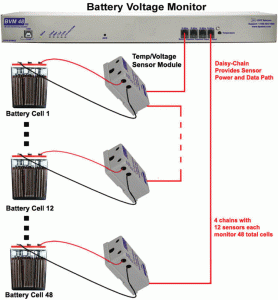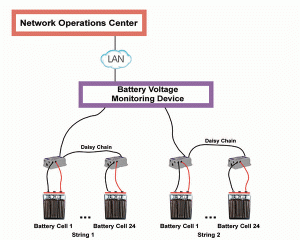Chris Kaundart, Tech Writer
DPS Telecom
Do you know the status of your remote site battery plants? Would you know if one individual cell was falling out of its ideal voltage or temperature range? At a lot of companies, battery cell monitoring is a commonly overlooked opportunity to reduce costs and improve reliability.
This creates a huge problem. If you’ve ever had battery failures in the past, you know just how painful they can be. A single bad cell can dramatically affect an entire string of batteries if you don’t catch it early. An entire site could easily go dark if your batteries aren’t working properly or become fully discharged.
Unfortunately, monitoring batteries isn’t always as simple as slapping a single voltage monitor on each string. To really understand the big picture, you need to understand a lot of little pictures of cell voltage and temperature.
Monitoring your battery power doesn’t have to be a hassle. Just follow this guide to learn more about effective battery voltage monitoring.
The Four Primary Benefits of Monitoring Your Batteries

Leaving your battery cells unmonitored opens the door for far too many problems that are easily avoidable. Here are four of the main benefits you’ll see when you deploy your own battery monitoring system:
1. Prevent Outages
The first and biggest benefit of battery monitoring is the ability to prevent many power-related outages. When your battery cells are left unmonitored, you’re in the dark and constantly guessing about their status. Creating a reliable network requires continuous network monitoring, otherwise a small issue can quickly turn into a serious problem.
What if your critical backup batteries are all discharged and power fails at a site? This is a far too common disaster because many companies don’t take their backup power seriously, even if they think they do. With a battery monitor in place, you would have known your batteries were discharging long before it became an issue. You might, for example, have dispatched a portable generator that you might not have previously. These kinds of simple outages and headaches aren’t hard to prevent; the key is knowing there’s a problem.
2. Detect Problems with Individual Bad Cells
Since a single bad battery cell can dramatically degrade the performance of an entire string of batteries, it’s critical to deploy a thorough battery monitoring system. Monitoring the entire string is better than no monitoring at all, but it’s not the most effective way to improve reliability.
A good battery monitor will have sensors to monitor each of cells individually, looking not just for low voltages but a difference between the cells and the average of all the cells.
3. Avoid Complete Battery Discharges
Your batteries won’t be very useful if they’re completely drained. What’s worse is that a drained string can, in some cases, delay or prevent the site from coming back up even after power has been restored. With a monitoring device in place, you can set thresholds for notification. This means if the battery power drops below a certain percentage, you’ll receive a notification and can quickly respond.
Let’s face it, batteries are a part of your safety net and nothing is worse than a false sense of security. If your primary power goes down, that’s precisely when you’ll need your batteries the most. If your units are drained or otherwise impaired, then your site will go completely dark long before they should; meaning the critical network gear both you and your customers rely on will be down. Had you known that your backup batteries were low, you could have ensured they weren’t completely discharged.
4. Monitor Temperature Issues
It’s not enough to only monitor voltage. Battery cells can get abnormally hot when they are failing, so including temperature monitoring can help detect battery issues long before they can cause serious issues. Early notification gives the time needed to respond to problems in a controlled manner. Including temperature monitoring with voltage monitoring is the only way to thoroughly and completely monitor your battery cells.
The 11 Features of a Quality Battery Voltage Monitor

A battery voltage monitor won’t be truly effective without the right features. It’s far too common for a vendor to skimp on hardware/software features and cut corners to reduce costs, only to leave out the critical features needed for a truly effective monitoring system.
A limited and poorly designed battery monitor will end up costing you big in the long-run. You think you’re saving money until your network goes down because the battery voltage monitor wasn’t up for the job. Don’t settle for inadequate monitoring; make sure the battery monitor has these 11 must-have features.
1. Adequate Capacity
Some battery voltage monitoring systems don’t support the capacity to handle large quantities of battery cells. It’s absolutely essential that you have the full support to monitor each battery cell, otherwise you’ll find yourself vulnerable to the weakest link in the battery string. Most critical sites will have A/B power battery systems. Look for a single device that is capable of monitoring both strings of batteries. Not all strings are created equal; make sure the solution can monitor a 125 VDC string.
2. SNMP Support
What good is a battery voltage monitor if it has no way of reporting problems to you? With a device that supports SNMP, you’ll be able to receive SNMP traps to a central NOC or master station to notify you if there’s an issue with the batteries. This means you can easily bring battery monitoring under the SNMP monitoring umbrella. Notifications are the key to preventing outages caused by issues with the batteries.
3. 24/7 Notifications
When it comes to monitoring batteries, and therefore protecting your uptime, you want true flexibility. Having the capability to receive 24/7 notifications (via SMS text message, email, voice alerts, etc.) about the status of your batteries can be the difference between an outage and keeping power to your gear.
Even if you have a 24/7 NOC (network operations center), receiving on-the-fly and mobile notifications can provide an edge in avoiding preventable outages. Look for a battery monitor that can send alerts via emails, SMS text messages, paging, etc. With flexible alerts that can notify you out of the office, you can be assured you won’t be left in the dark.
4. Continuous Voltage Reading
Battery voltage monitoring equipment needs to provide continuous voltage readings. Without regular monitoring or at least control over the sampling rate, a problem can linger for too long before you’re notified.
That’s why sampling batteries at too long of intervals can be problematic. Battery cells can easily become fully discharged between lengthy interval readings, which means the risk losing power at your sites and not have any idea until the entire site suddenly goes dark. With real-time monitoring and customizable interval samples, you can be assured to know about these kinds of emergencies before they bring down mission-critical network equipment.
5. Accurate Voltage Measurement
If the battery voltage monitor can’t accurately measure voltage and temperature, then you may as well have no monitoring at all. An effective battery monitor will be able to provide accurate readings within 1 percent of the actual value. With an accurate battery monitor, you can be assured to truly know the status of the batteries.
6. Integrated Alarm Monitoring
Support for an integrated RTU (remote telemetry unit) can provide additional value from the same rack unit of space. An RTU can collect environmental alarms (about temperature, humidity, smoke, power, etc.) and monitor critical network equipment at remote sites and report these alarms back to you. This means you can monitor additional pieces of equipment from the same device that’s monitoring the battery cells.
Having integrated alarm monitoring means you can get even more ROI from the battery voltage monitor. You can monitor other pieces of gear and environmental conditions to improve service reliability at the remote sites. You can enjoy the peace of mind knowing that you’re fully monitoring all of the conditions at the sites to avoid preventable outages.
7. Web Interface
A device with a Web interface will present you with powerful network management tools. Instead of driving all the way out to a site to configure or manage a device, you can do it right from your desk. This can save on fuel costs and expensive man hours.
You may be a large company with an enterprise-grade SNMP manager, but a Web interface lets you drill down when you need to. An intuitive and easy-to-use Web interface is head-and-shoulders above any other method to manage battery monitoring.
8. Historical Trending

A battery monitor with an analog logging feature will allow you to graph historical trends of the battery monitoring data from the Web page. With graphical data, you’ll be able to analyze battery voltage information and observe patterns with the batteries. Or, if you ever need to reference past data about the battery voltage, you’ll have the historical graphs at your disposal.
You want this historical data stored both locally on the device and within the network management system (NMS). In case not all staff have access to the NMS, they will still have local access to the history data.
9. Daisy-Chainable
You don’t want sites to be a messy pile of cables and you certainly don’t want a device that is needlessly complicated to set up. Having battery voltage sensors that are daisy-chainable makes setup easy and clean. Just string the sensors along from each other, rather than running long cables from the battery monitor to each individual sensor.
Daisy chaining sensors improves accuracy, is a setup timesaver and transmits data digitally. You can also keep high current away from places you don’t want it. Daisy chaining is the easiest and best way to simplify monitoring setup.
10. Flexible Battery Support
You’ll want a battery monitor to have the ability to work with different battery types and voltages. All batteries are not the same, they have different orientations, connectors and different voltage ranges. For instance, you might have a standard string of batteries or a string with four 12 V cells and propriety connectors. You need a battery monitoring system that is very adaptable.
11. Local Voltage Isolation
You have to have sensors that isolate voltage locally. This allows for more accurate battery readings and creates a safer environment. Keeping the voltage reading local then transmitting a digital signal back to headquarters equals having accurate cell readings and you don’t have to deal with the hazards of transporting battery voltage.
Adequately Protecting Uptime
Monitoring battery cells doesn’t have to be a struggle. Adding a battery voltage monitor to a network is a simple solution that can provide you with some serious value. You’ll be able to save time and money, not to mention greatly improve the reliability of the network.
For more information, please contact DPS Telecom at www.dpstele.com.







